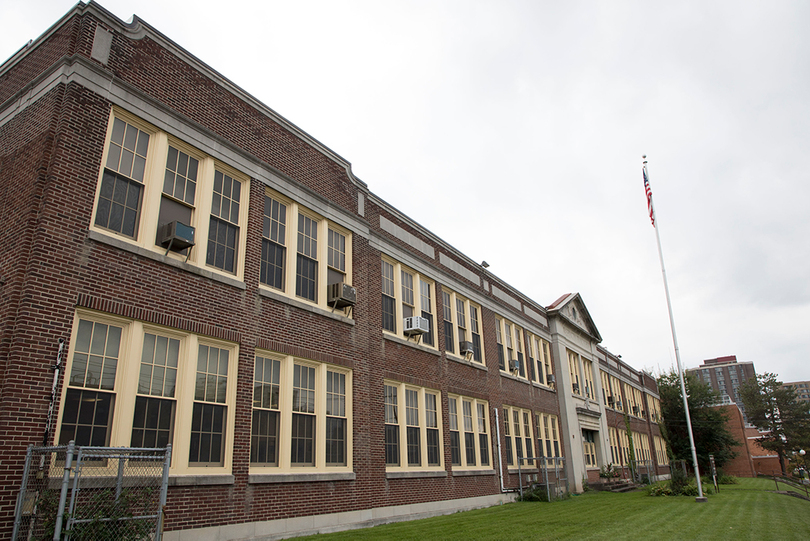Syracuse city schools struggle to provide students access to daily meals

Students can pick up meals at any of the district’s schools, regardless of whether the students are attending class in person or online. Daily Orange File Photo
The Daily Orange is a nonprofit newsroom that receives no funding from Syracuse University. Consider donating today to support our mission.
A month after resuming classes, the Syracuse City School District faces challenges with providing some students with regular access to healthy food.
Since suspending in-person classes in March, the district has worked with community organizations to provide thousands of meals for its students, more than 80% of whom qualified for free or reduced-price meals before the pandemic began. But as students’ needs for food assistance have grown, so have the challenges associated with getting meals to the families who need them most.
“There’s just been such an impact on the average American household that we know that there’s been a huge increase in need,” said Rachel Murphy, director of Food and Nutrition Services in the district.
In the early stages of the pandemic, school officials realized that it could become increasingly difficult for students and their families to access school-provided meals, especially for families struggling financially or left with limited transportation options due to the pandemic.
That became a very real concern for the district, Murphy said.
The district now provides between 4,000 and 5,000 meals for students each day, which is “not nearly” as many as the district was serving before the pandemic, Murphy said. Ensuring that students and their families know where and how to pick up meals has proven especially difficult, she said.
Students can pick up meals at any of the district’s schools, regardless of whether the students are attending class in person or online, Murphy said. The district has provided information about meal distribution programs on their website and taken to social media, local radio and television to make sure the message reaches as many members of the community as possible, she said.
Precious Walker, a member of the SCSD Educational Foundation board of directors, said problems accessing meals from the district go beyond families’ knowledge of the programs.
Though the district is currently using a hybrid-learning model — where students attend class in person some days and online others — some students are still learning fully online, Walker said. Many of those students’ caregivers don’t have reliable access to transportation or can’t leave work during the day, they said.
“Trying to leave and pick up a meal is not feasible,” Walker said. “When you get to a point where you can just tread water in Syracuse, you’re forgotten and you don’t get any help. And that’s the missing link that’s going on with the food issue in this district.”
SCSD has been working with community partners to fill these kinds of gaps in its programs, Murphy said.
“We’ve done a lot of work in having community partners assist us in reaching out to those families, even though they’re not able to come out or they don’t want to or there’s a physical reason they can’t,” she said.
Local organizations, such as the Good Life Foundation, have delivered hundreds of meals for students whose families weren’t able to pick them up in person, Murphy said. The district has also been able to deliver meals to people with disabilities as well as those in quarantine by using lists from Onondaga County and the Centers for Disease Control and Prevention, she said.
Lower than normal participation in the district’s meal programs this year may also be due in part to the work local organizations have been doing amid the pandemic, Murphy said.
“I don’t believe the lower participation is related to a lack of need,” Murphy said. “There are more options for our community to access now, which is wonderful.”
Mercy Works, another local organization SCSD has partnered with, has packed more than 30,000 boxes of groceries during the pandemic to help families with children in school, said Joelle Harleston, director of development and community relations at Mercy Works. The group has provided nearly 900,000 pounds of groceries to assist families with meals and nutrition on the weekends, Harleston said.
School districts need to embrace these kinds of community partnerships and use existing federal and state aid programs to help feed students, said Rachel Sabella, director of No Kid Hungry New York.
“There is not one solution to solving this problem, but it’s so important that all of these programs work together,” Sabella said.
New York state has continued to expand Pandemic-EBT, a new program that gives $420 in food benefits to every child who has lost access to free or reduced-price school meals because of the pandemic, Sabella said.
Identifying and working to overcome food access challenges has been a group effort by district officials from a variety of backgrounds and members of the community, Murphy said.
“If anyone thinks it’s just riding on one person’s back alone, it never has been, and it never will be,” Murphy said. “The city isn’t just the school system — it is many, many agencies, organizations and individuals.”





